

Keiler Roberts wouldn’t call herself a life coach. Judging by her self-deprecating autobiographical comics, she would balk at the idea of herself as a figure of inspiration. But whenever I finish one of her books, I leave with new lessons in how I should lead my life: cherish the small stuff; don’t run from reality; pay attention to your mental health; accept the bad you can’t control and push through to create more good. For the last three years, Koyama Press has released an annual collection of Roberts’ diary comics: Sunburning, Chlorine Gardens, and this year’s Rat Time. Each year these are some of the funniest comics to see print, finding humor in everyday exchanges between Roberts and her family while turning sadness and gloom into punchlines.
In Sunburning, Roberts recounts a doctor giving her a copy Stephen Covey’s The 7 Habits of Highly Effective People during a low-energy period in high school. She immediately laments the book’s length and says that a highly effective person would never finish it, a small moment that speaks significantly to why Roberts’ comics are so effective at imparting wisdom. They are short and easy to digest, with varying panel layouts and joke structures that change the rhythm and turn unspectacular subject matter into an exciting read.
Roberts’ first two Koyama titles are heavier reads that recount particularly trying times for the cartoonist. In Sunburning, Roberts writes about her miscarriage and being honest about her bipolar disorder with her young daughter, Xia. In Chlorine Gardens, Roberts details the pain of being in labor and tells of how she was eventually diagnosed with multiple sclerosis, a process involving a long series of doctor’s visits and false hypotheses as to what was causing her strange symptoms. The MS diagnosis is confirmed at the very end of Chlorine Gardens, so I expected that to be a major element of Rat Time, which it both is and isn’t. The rats she buys for her daughter, Mateo and Sammy, are intended to distract Roberts from her disease, and it works until she realizes that the rats’ initials are M and S. She laughs off the coincidence instead of lingering on it, but that moment re-contextualizes all of the other scenes of Roberts and Xia playing with their pets.
In Sunburning, Xia looks at her mother’s hair and lovingly calls it a “rat’s nest,” establishing an affection for the rodents before they ever become a viable pet prospect. The seeds of rat ownership are planted with a pet-store visit in Chlorine Gardens, and they blossom in Rat Time, when Roberts excitedly tells her daughter that Dad is finally letting them get rats! That excitement doesn’t last. Before they even leave the store, Roberts gets a glaring reminder of her new pets’ mortality as they wait in line to check out. While Xia stares affectionately at the cage holding her two new furry friends, Roberts is horrified by the bag of dead mice bought by the woman in front of her. The contrast of the mother and daughter’s expressions heightens the dark humor, and the tortoise in the corner is the cherry on top, a symbol of longevity in the middle of a moment all about the fleeting nature of life.
And surely enough, the rats don’t live long. Mateo makes it one whole day before Roberts finds him dead in the cage (he’s immediately replaced by Mateo Too), and Sammy eventually joins him in the garbage. Rat Time’s most profound line comes from Xia after losing her first two rats: “‘Rat time’ doesn’t mean the same thing anymore. It’s not a time of day. It’s the time when we had rats.” It’s one of the first instances of Xia being wistful, experiencing a longing for the past that will only get more intense as she gets older. The joke here is that this is literally happening during “rat time,” with the next panel revealing an annoyed Roberts on the floor with Mateo Too, who is propped up inside a toy fire truck.
One of the biggest takeaways from Roberts’ comics is that nothing is too small to appreciate. She’s always been enthralled by tiny objects and dolls, a recurring motif in Rat Time, and her books are largely composed of relatively insignificant personal interactions that perk up her spirit. That focus on small things informs Roberts’ art, and some of the most detailed elements of her work are these objects. Rat Time begins with Roberts and Xia at a store, standing in front of a wall of meticulously drawn hair accessories. Later in the book, Roberts uses this attention to detail to disturb the reader as she recounts seeing a skinless corpse for a college art class. She compares the muscle to shredded chicken, with an accompanying image of two forks in a shredded pile of meat, and dried squid, with an accompanying image of a flayed hand in a small CorningWare dish.
The relationship between Roberts and her daughter is the strongest emotional through line of her books, and it’s a delight to see how that relationship changes as Xia grows up. As Xia gains more autonomy and knowledge, she becomes more aware of her mother’s idiosyncrasies and positions herself as support in a way she hasn’t in the past. Two strips in Rat Time exemplify this shift. One features Xia at 3 years old, crying at the bathroom door while her mother is trying to switch out a tampon. It’s a chaotic scene emphasizing how a young child’s relentless need for comfort and affection amplifies a parent’s already high stress level. In a later strip, Xia accompanies her mother to the hospital for a blood test. Even though blood-drawing is scary, Xia says that she’ll watch it because it’s Halloween.
The image of Xia putting her hand on her mother’s arm is an important one for Roberts, who turns it into the endpapers for Rat Time, repeating this shot in a diamond pattern. The endpapers of these books, always a pattern built from a single image in the strips, play a fascinating part in the storytelling. The endpapers for Sunburning and Rat Time are connected, showing Xia at two very different points in her life. Sunburning’s endpapers form a double helix using an image of a frightened young Xia standing in her footie pajamas, pulled from the punchline of a later page. The strip has Roberts asking her daughter what she’s thinking, to which Xia replies, “I’m scared. Scared of the dark. And of lotion.”
This line is a classic example of a Xia gag, funny because it’s so pure and so random. Xia’s at an age where logic hasn’t really come into play yet, and her mother takes immense joy in capturing these goofy moments where she gets a glimpse inside her daughter’s unpredictable mind. The DNA-like arrangement of Xia in those endpapers positions her as the foundation of these stories, and Sunburning spends considerable time dissecting Roberts’ anxieties about making her daughter such an integral part of her creative output. She worries that Xia’s peers will discover these stories and make fun of her as she gets older, but eventually comes to accept that it’s more important that she capture these moments than let them fade from memory. Any of that anxiety is gone by Rat Time, and in general, she’s in a much more comfortable place in her latest book.
Chlorine Gardens’ endpapers tell a story on their own, showing Roberts’ favorite glass in two different contexts. At the front of the book, she pairs the glass with a handle of vodka, presented at a front-facing angle so that there’s a straight horizontal line across the page. The pattern is calm and smooth when the glass is paired with alcohol, but as someone who no longer drinks, Roberts can’t rely on booze to take the edge off. She pairs the glass with milk for the back endpapers, creating a jagged pattern by incorporating the sharp angle of the kitchen countertop edge from a higher angle. The vodka and the milk panels appear side by side inside the book, but by transforming them into endpaper patterns, Roberts spotlights how she uses angles and geometry to enrich the expressive qualities of an image. When that craft merges with wit and emotional honesty, the results are hilarious and illuminating.
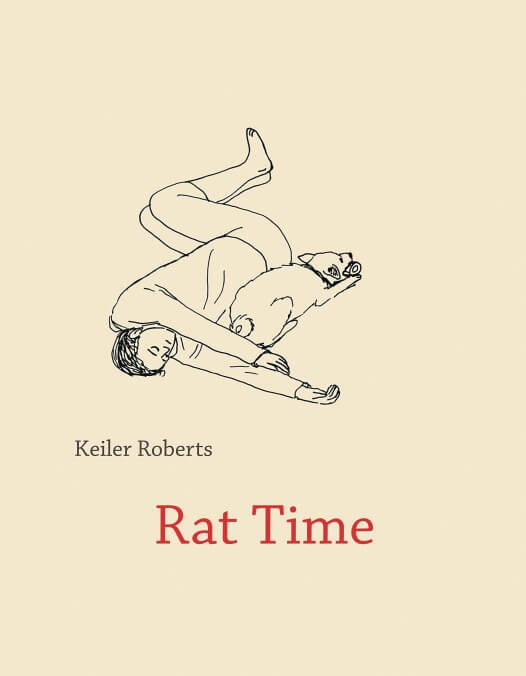
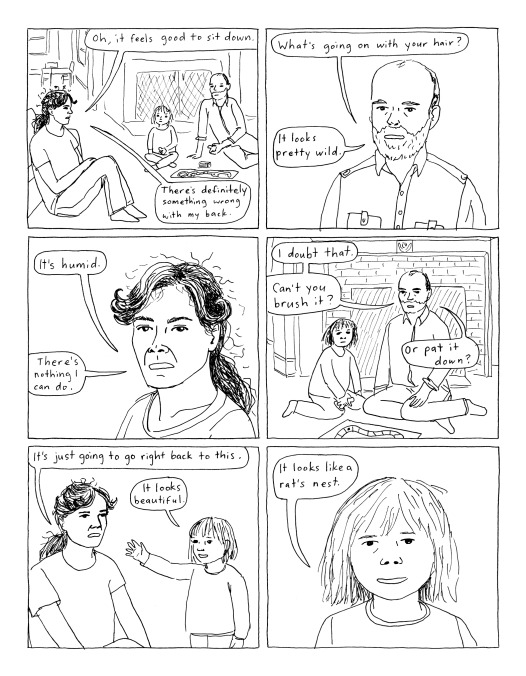
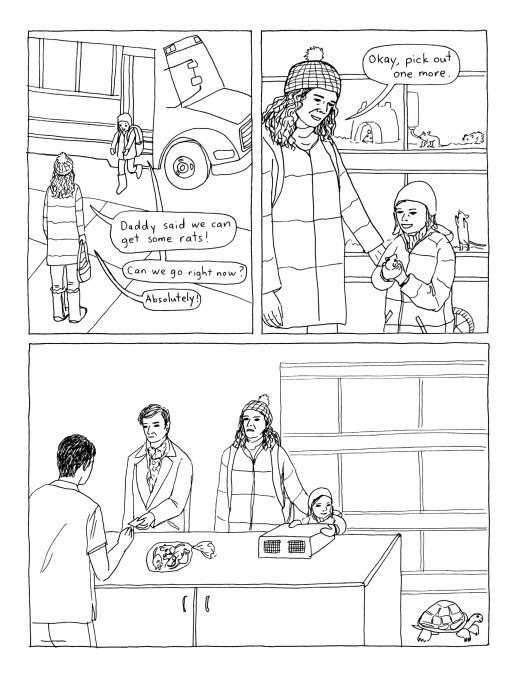


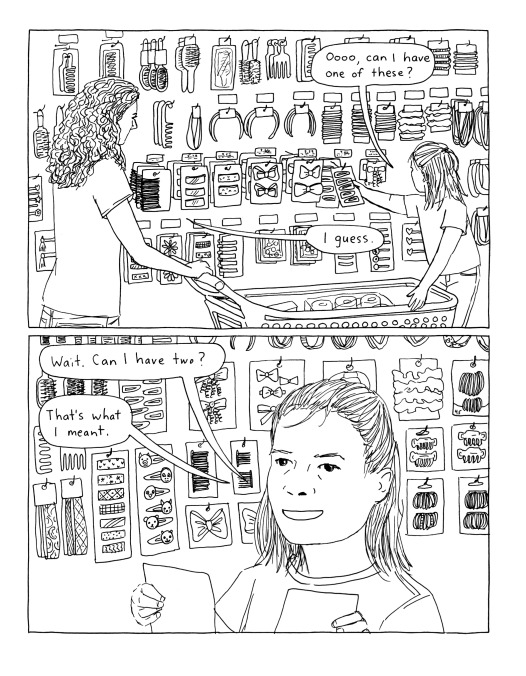
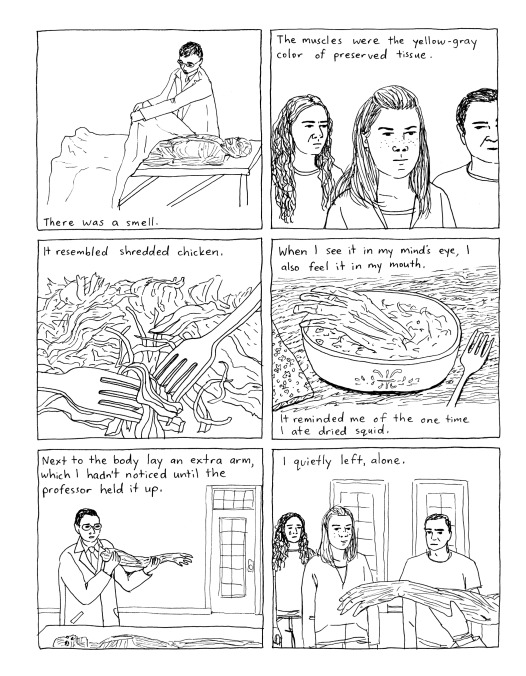
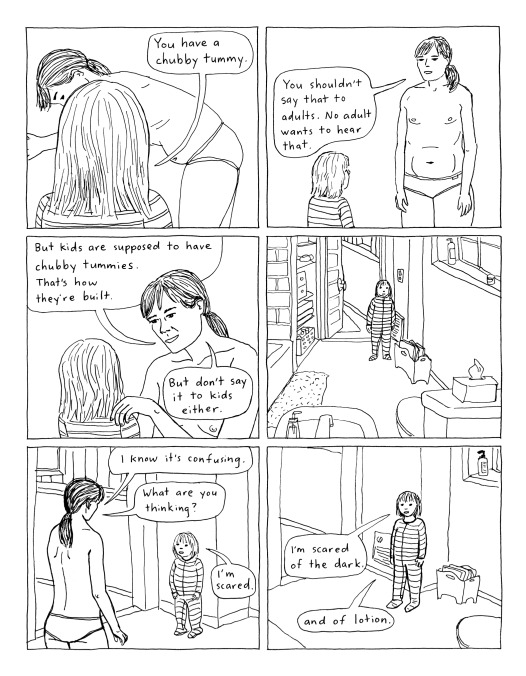
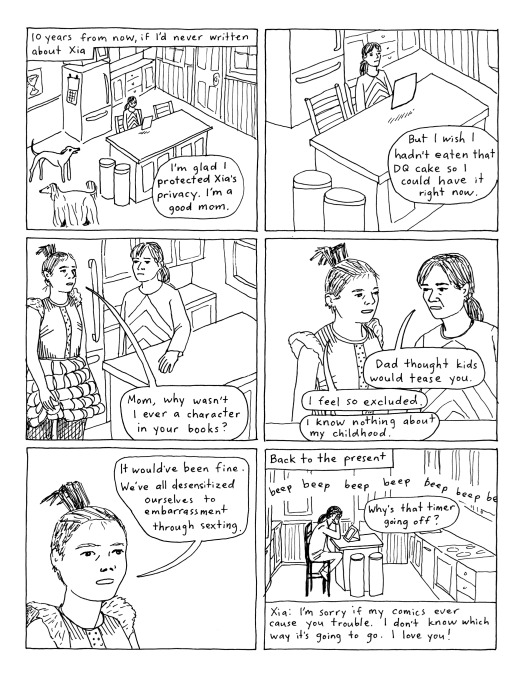
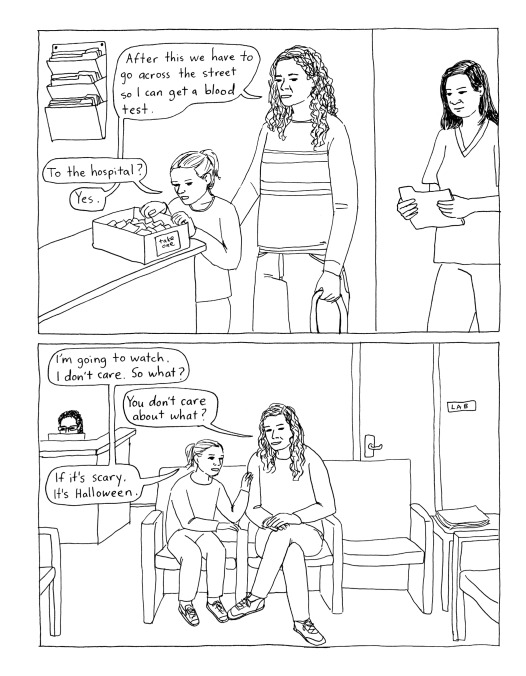
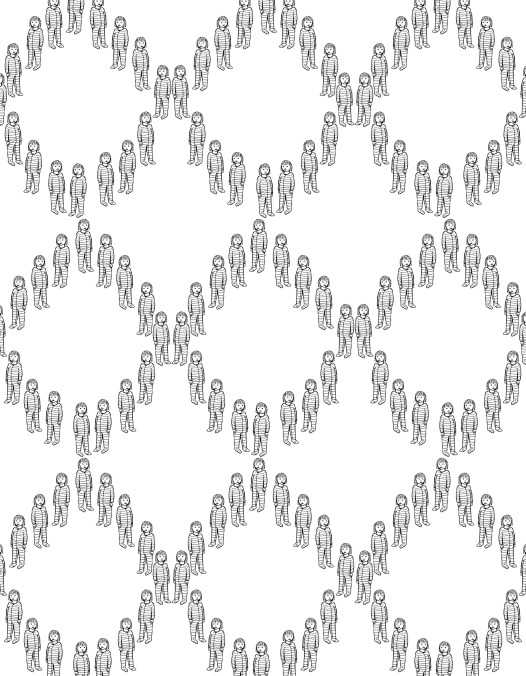
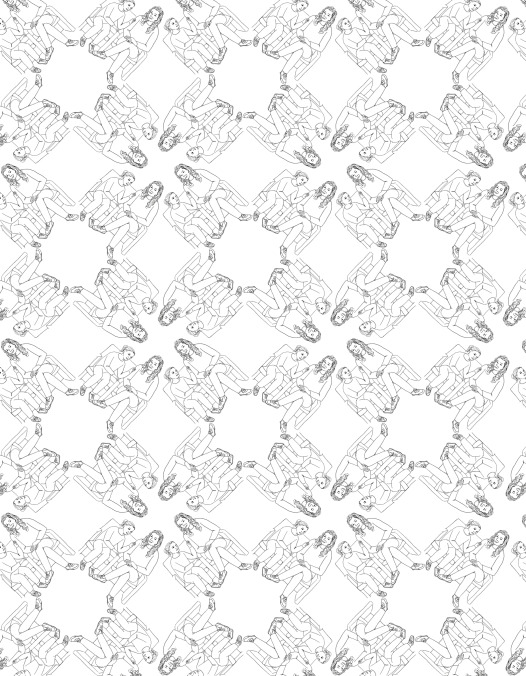
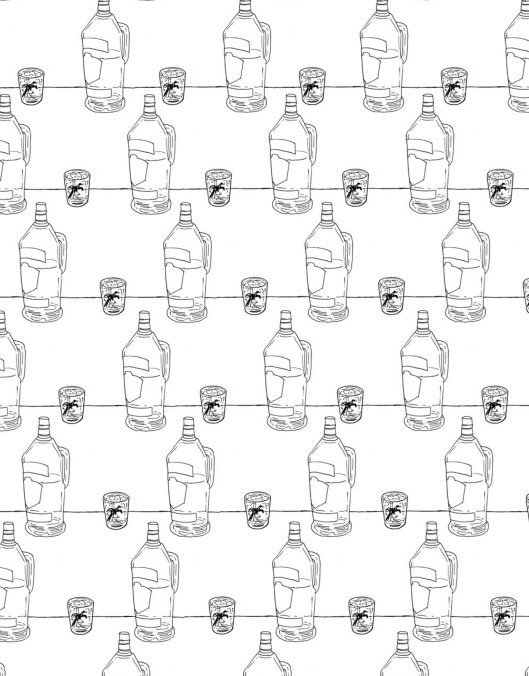
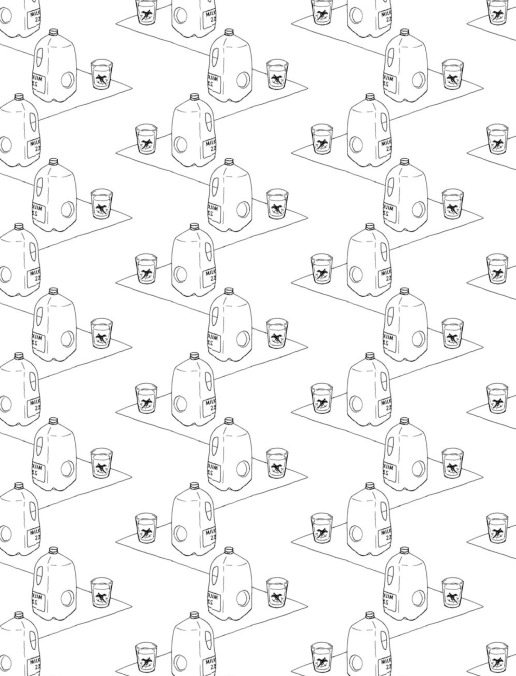
3 Comments
Ok, when the pet store clerk tied them in a plastic bag like goldfish at check-out, I chuckled.
I worked in a pet store the whole time I was in mortuary school. The bag o’ dead mice is a familiar (and frequently amusing, depending on the reactions of other customers) sight.
How about the sign that says: “We do not sell live food. These rats are sold as pets. If you need rats for your python etc, you can find them in the large freezer near the dog food section.”